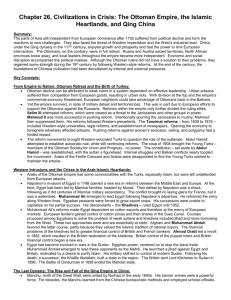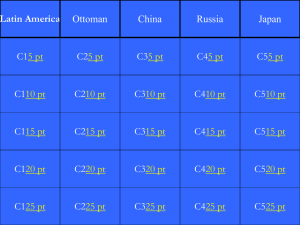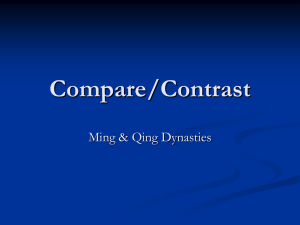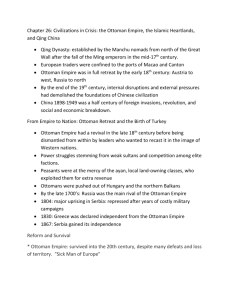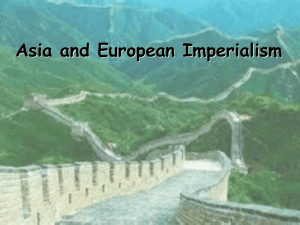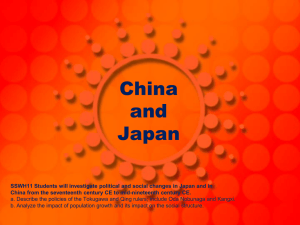Civilizations in Crisis: The Ottoman Empire, the
advertisement
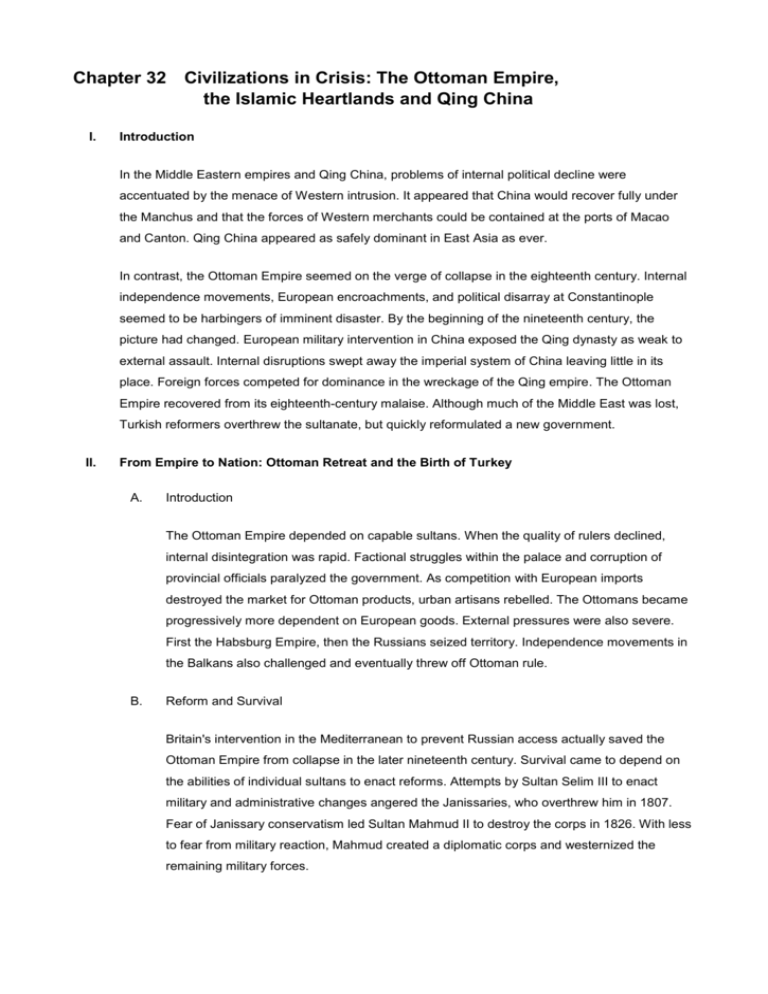
Chapter 32 Civilizations in Crisis: The Ottoman Empire, the Islamic Heartlands and Qing China I. Introduction In the Middle Eastern empires and Qing China, problems of internal political decline were accentuated by the menace of Western intrusion. It appeared that China would recover fully under the Manchus and that the forces of Western merchants could be contained at the ports of Macao and Canton. Qing China appeared as safely dominant in East Asia as ever. In contrast, the Ottoman Empire seemed on the verge of collapse in the eighteenth century. Internal independence movements, European encroachments, and political disarray at Constantinople seemed to be harbingers of imminent disaster. By the beginning of the nineteenth century, the picture had changed. European military intervention in China exposed the Qing dynasty as weak to external assault. Internal disruptions swept away the imperial system of China leaving little in its place. Foreign forces competed for dominance in the wreckage of the Qing empire. The Ottoman Empire recovered from its eighteenth-century malaise. Although much of the Middle East was lost, Turkish reformers overthrew the sultanate, but quickly reformulated a new government. II. From Empire to Nation: Ottoman Retreat and the Birth of Turkey A. Introduction The Ottoman Empire depended on capable sultans. When the quality of rulers declined, internal disintegration was rapid. Factional struggles within the palace and corruption of provincial officials paralyzed the government. As competition with European imports destroyed the market for Ottoman products, urban artisans rebelled. The Ottomans became progressively more dependent on European goods. External pressures were also severe. First the Habsburg Empire, then the Russians seized territory. Independence movements in the Balkans also challenged and eventually threw off Ottoman rule. B. Reform and Survival Britain's intervention in the Mediterranean to prevent Russian access actually saved the Ottoman Empire from collapse in the later nineteenth century. Survival came to depend on the abilities of individual sultans to enact reforms. Attempts by Sultan Selim III to enact military and administrative changes angered the Janissaries, who overthrew him in 1807. Fear of Janissary conservatism led Sultan Mahmud II to destroy the corps in 1826. With less to fear from military reaction, Mahmud created a diplomatic corps and westernized the remaining military forces. In the Tanzimat reforms from 1839 to 1876, Westernization was introduced to other facets of Ottoman society. University education was reorganized, postal and telegraph systems were introduced, newspapers were established, and legal reforms were mandated. A new constitution along Western lines appeared in 1876 as the culmination of the reforms. Artisans suffered from the opening of the Empire to Western trade, and women gained little from the reforms. C. Repression and Revolt As the reforms produced a Western-educated elite, many came to view the sultanate itself as archaic. Sultan Abdul Hamid reacted to the perceived threat by nullifying the new constitution and imprisoning many of the Western-oriented elite. Resistance to Abdul Hamid's reactionism led to his overthrow by the Young Turks in 1908. A group of military officers seized the government, restored the constitution, and promised additional reforms. The sultan was reduced to a powerless religious figurehead. The officers who ran the government proved no more successful than the sultans in maintaining the farther outposts of the Ottoman Empire. Arab portions of the empire became increasingly resistant to the maintenance of Turkish rule. Turkish participation in World War I on the side of the Germans initiated the final dissolution of the Ottoman Empire. III. Western Intrusions and the Crisis in the Arab Islamic Heartlands A. Introduction By the early nineteenth century, the Ottomans had controlled the Arab peoples of the Middle East for centuries. Arabs were aware of the diminishing capacity of the Turks to defend them from European encroachments. B. Muhammad Ali and the Failure of Westernization in Egypt Following the French withdrawal from Egypt in 1801, Muhammad Ali, an Albanian army officer, emerged as the ruler of the region. Muhammad Ali introduced Western-style military reforms that enabled him to ignore the Ottoman sultan. Muhammad Ali extended his control to Arab Syria. Attempts to introduce economic reforms based on the production of commercial crops for export were less successful. Diversion of available money to the military forced Muhammad Ali to ally with the ayan and suppress the peasantry. After his death in 1848, Muhammad Ali's successors were unable to maintain his military dominance and retreated to Egypt and the Sudan. The successors were referred to after 1867 as khedives. C. Bankruptcy, European Intervention and Strategies of Resistance Muhammad Ali's successors continued his general plans with disastrous results. Cotton production expanded at the expense of food products. As a single export commodity, Egyptian cotton was vulnerable to price and demand swings in the world market. Educational reforms were limited to the elite. The general population barely profited from the reforms. By the middle of the nineteenth century, the khedives were heavily in debt to European creditors. Europeans were attracted to Egyptian cotton and the plan to construct the Suez Canal, completed in 1869. Islamic intellectuals met in Egypt to discuss means of expelling the European threat. Some argued for strict Islamic religious observance, others for greater Westernization in science and technology. The two groups were unable to reconcile their different approaches. French and British investors, who held the majority of shares in the Suez Canal, urged their governments to intervene directly in Egypt. An Egyptian army rebellion under Ahmad Orabi induced the British to send military units to Egypt in 1882. Thereafter the administration of Egypt was in the hands of British consuls. D. Jihad: The Mahdist Revolt in the Sudan Egyptian forces had long been engaged in attempts to extend control down the Nile River into the Sudan. The khedives enjoyed little success, and their control was limited to towns, such as Khartoum. Attempts in the 1870s to eliminate the slave trade added to the discontent with Egyptian overlordship in the Sudan. Resistance to Egyptian and British influence was focused by Muhammad Achmad, head of a Sufi brotherhood in the Sudan. Taking the title of Mahdi, Muhammad Achmad claimed descent from Muhammad and declared a jihad. He offered to purge Islam of foreign influences and restore purity. The military forces of the Mahdi enjoyed military success against the Egyptians until his death from disease. His role as leader of the Sudan insurgence was taken by Khalifa Abdallahi. A British expeditionary forceled by General Kitchener finally defeated the Mahdist army in a campaign from 1896 to 1898. The British thus extended their power along the Nile. E. Retreat and Anxiety: Islam Imperiled Much Islamic territory passed under the control of Western forces during the nineteenth century. Ottoman reformers and religious revolutionaries were able to slow the process, but not halt it entirely. Islamic civilization became increasingly anxious over its fate. IV. The Last Dynasty: The Rise and Fall of the Qing Empire in China A. Introduction Nurhaci was able to unite the Manchu nomads under eight banner armies and to introduce Chinese administrative reforms into Manchu government. After a local Chinese official invited the Manchus within the Great Wall, the nomads advanced and captured the Ming capital at Beijing in 1644. As a result, the Manchus were able to establish a new dynasty, the Qing. The Qing incorporated much of the former Ming state, including the scholar-gentry, but assumed a more direct role in appointment of local officials. Ethnic Chinese continued to be admitted into the imperial government. The Manchus, unlike the Mongols, retained the civil service examination system. B. Economy and Society in the Early Centuries of Qing Rule The Manchus preserved the integrity of the Confucian social hierarchy. Women continued to be subject to patriarchal authority in the household, although they might hope to gain some control over household activities. Widows were permitted to remarry. The Qing attempted to relieve distress among the Chinese peasantry, but population pressures made their efforts virtually useless. As the value of labor fell, rural landlords gained a stranglehold over the rural economy. Commercial and urban expansion continued under the Qing. Profits from overseas exports produced a new group of merchants, the compradors, who specialized in silk exports. C. Rot from Within: Bureaucratic Breakdown and Social Disintegration By the late eighteenth century, corruption riddled the civil examination system. Posts became hereditary or available for purchase. Wealthy families used the bureaucracy as a means of establishing local authority. Revenues were diverted from state projects to enrich local bureaucrats. Spending on the military and public works projects declined. Floods wiped out some of China's most productive farm land. Food shortages produced widespread peasant migrations and banditry. Problems were of such scale that the normal cycle of dynastic decline and replacement was threatened. D. Barbarians at the Southern Gates: The Opium War and After By the nineteenth century, a new type of barbarian, the Europeans, threatened China. Initial confrontations arose over the British plan to export opium from India to China in order to improve the European balance of trade. The Qing government recognized the threat to both their economy and their society posed by unlimited importation of opium. In the 1830s, the Qing emperor appointed Lin Zexu, a renowned bureaucrat, to stamp out the opium trade. Lin blockaded Canton and confiscated European opium supplies. British merchants demanded that their government intervene to protect investments. In 1839, the British routed the Chinese junks in the first stages of the Opium War. When the British sent a military force ashore, the Qing emperor sued for peace. By the 1890s, 90 Chinese ports were open to European, Japanese, and American merchants. Britain, France, Germany, and Russia actually leased certain ports and their hinterlands. Trade passed increasingly into the hands of the non-Chinese, and the Qing court was forced to accept European diplomats. E. A Civilization at Risk: Rebellion and Failed Reforms Defeat at the hands of the Europeans helped to set off a series of rebellions against the Qing. In the 1850s and 1860s, the Taiping rebellion, a semi-Christian movement under a prophetic leader, called for land redistribution, the liberation of women, and the destruction of the Confucian scholar-gentry. When the local gentry became sufficiently alarmed, provincial forces finally defeated the rebellion. Honest officials at the provincial level began to carry out much needed reforms, including railway construction and military modernization. Resources moved from the central court to the provinces, until the provincial leaders posed a real threat to the Qing government. The Manchus continued to obstruct almost all programs of reform, despite repeated defeats at the hands of the Europeans and the Japanese. The last decades of the dynasty were dominated by Cixi, the dowager empress. Cixi refused all attempts at reform. The dowager empress clandestinely supported the Boxer Rebellion from 1898 to 1901 as a means of ousting foreign influence. F. The Fall of the Qing Resistance to the Qing at the end of the nineteenth century was centered in secret societies, which sponsored local uprisings against the central government. The involvement of Western-educated compradors and some of the scholar-gentry gave these scattered movements more focus. Although they drew on Western ideas for a reformed government, the revolutionaries wanted to restore Chinese territorial integrity and expel foreigners from their soil. In 1911, widespread uprisings throughout China could not be put down by provincial officials. In 1912, the last Qing emperor, Puyi, a boy of 12, abdicated. G. The End of a Civilization? Even prior to their abdication, the Qing had abandoned the Confucian examination system as inappropriate to the problems of the government. Abandonment of the examinations signaled the end of patterns of civilization in China first established almost two and one half millennia before. V. Conclusion: Islamic and Chinese Responses to the Challenge of the West Compared The Muslims were long accustomed to the military threat posed by the West. In China, the West's military dominance in the nineteenth century came as a rude surprise. The Muslims could justify some borrowing from the West on the basis of a shared cultural foundation the Judaeo-Christian and Greek heritage from which both civilizations drew. China had remained intentionally culturally isolated from the West. They regarded Western culture as barbaric. More politically fragmented than the Chinese, the Muslims had time to learn from early mistakes. The Chinese equated the survival of the civilization with the maintenance of the Qing dynasty. When the dynasty collapsed, Chinese civilization was destroyed. Muslims could always fall back on religious faith as a last resort. The Chinese had no great religious tradition with which to counter European belief in its inherent superiority.

